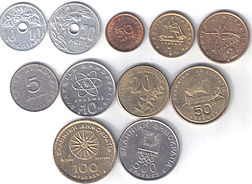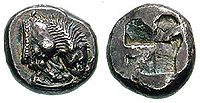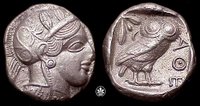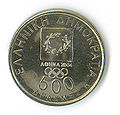- Greek drachma
-
ελληνική δραχμή (Greek) 
Modern drachma coins ISO 4217 code GRD User(s)  Greece
GreeceInflation 3.1% (2000) Source Grecian.net ERM Since March 1998 Fixed rate since 19 June 2000 Replaced by €, non cash 1 January 2001 Replaced by €, cash 1 January 2002 € = 340.750 Δρ. Subunit 1/100 leptοn Symbol Δρχ., Δρ. or ₯ Coins Freq. used 5, 10, 20, 50, 100, 500 Δρ. Rarely used 10c, 20c, 50c, 1 and 2 Δρ. Banknotes Freq. used 100, 200, 1000, 5000, 10000 Δρ. Rarely used 50, 500 Δρ. Central bank Bank of Greece Website www.bankofgreece.gr Printer Bank of Greece[citation needed] Website www.bankofgreece.gr Mint Bank of Greece[citation needed] Website www.bankofgreece.gr This infobox shows the latest status before this currency was rendered obsolete. Drachma, pl. drachmas or drachmae (δραχμή, pl. δραχμές or δραχμαί (until 2002)) was the currency used in Greece during several periods in its history:
- An ancient Greek currency unit found in many Greek city states from Classical times on, as well as in many of Alexander's successor states and South-West Asian kingdoms during the Hellenistic era.
- Three modern Greek currencies, the first introduced in 1832 and the last replaced by the euro in 2001 (at the rate of 340.750 drachma to the euro). The euro did not begin circulating until 2002 but the exchange rate was fixed on 19 June 2000, with legal introduction of the euro taking place in January 2002.
It was also a small weight unit[1].
Contents
Ancient drachma
 Above: Six rod-shaped obeloi (oboloi) displayed at the Numismatic Museum of Athens, discovered at Heraion of Argos. Below: grasp[2] of six oboloi forming one drachma
Above: Six rod-shaped obeloi (oboloi) displayed at the Numismatic Museum of Athens, discovered at Heraion of Argos. Below: grasp[2] of six oboloi forming one drachma
The name drachma[3] is derived from the verb δράσσομαι (drássomai, "to grasp")[4]. It is believed that the same word with the meaning of "handful" or "handle" is found in Linear B tablets of the Mycenean Pylos[5]. Initially a drachma was a fistful (a "grasp") of six oboloí or obeloí (metal sticks, literally "spits") used as a form of currency as early as 1100 BC and being literally a form of "bullion": bronze, copper, or iron ingots denominated by weight. A hoard of over 150 rod-shaped obeloi were uncovered at Heraion of Argos in Peloponnese. Six of them are displayed at the Numismatic Museum of Athens. It was the standard unit of silver coinage at most ancient Greek and Roman mints, and the name 'obol' was used to describe a coin that was one-sixth of a drachma. The notion that "drachma" derived from the word for fistful was recorded by Herakleides of Pontos (387-312 BC) who was informed by the priests of Heraion that Pheidon, king of Argos, dedicated rod-shaped obeloi to Heraion. A similar information about Pheidon's obeloi was also recorded at the Parian Chronicle. Ancient Greek coins seldom had official names. Each city would mint its own and have them stamped with recognizable symbols of the city, along with suitable inscriptions, and they would often be referred to either by the name of the city or of the image depicted (e.g. the Aeginetan "turtles"). The exact exchange value of each was determined by the quantity and quality of the metal, which reflected on the reputation of each mint.
The 5th century BC Athenian tetradrachm ("four drachma") coin was perhaps the most widely used coins in the Greek world prior to the time of Alexander the Great (along with the Corinthian stater). It featured the helmeted profile bust of Athena on the obverse (front) and an owl on the reverse (back). In daily use they were called γλαῦκαι glaukai (owls),[6] hence the proverb Γλαῦκ’ Ἀθήναζε, 'an owl to Athens', referring to something that was in plentiful supply, like 'coals to Newcastle'. The reverse is featured on the national side of the modern Greek 1 euro coin.
Drachmas were minted on different weight standards at different Greek mints. The standard that came to be most commonly used was the Athenian or Attic one, which weighed a little over 4.3 grams.
After Alexander the Great's conquests, the name drachma was used in many of the Hellenistic kingdoms in the Middle East, including the Ptolemaic kingdom in Alexandria. The Arabic unit of currency known as dirham (in the Arabic language, درهم), known from pre-Islamic times and afterwards, inherited its name from the drachma or didrachm (δίδραχμον, 2 drachmae); the dirham is still the name of the official currencies of Morocco and the United Arab Emirates. The Armenian dram also derives its name from the drachma.
Value
It is generally considered very hard or even meaningless to come up with comparative exchange rates with modern currency because the range of products produced by economies of centuries gone by were very different from today, which makes Purchasing power parity (PPP) calculations very difficult. However, some historians and economists have estimated that in the 5th century BC a drachma had a rough value of 25 U.S. dollars (in the year 1990 - equivalent to 41 USD in 2009[7]), whereas classical historians regularly say that in the heyday of ancient Greece (the fifth and fourth centuries) the daily wage for a skilled worker or a hoplite[8] was one drachma, and for a heliast (juror) half a drachma since 425 BC.[9] Modern commentators derived from Xenophon[10] that half a drachma per day (360 days per year) would provide "a comfortable subsistence" for "the poor citizens" (for the head of a household in 355 BC). Earlier in 422 BC, we also see in Aristophanes (Wasps, line 300-302) that the daily half-drachma of a juror is just enough for the daily subsistence of a family of three.
As a rule of thumb, a modern person might think of one drachma as the rough equivalent of a skilled worker's daily pay in the place where they live (which could be as low as $1 USD, or as high as $100 USD, depending on the country). Perhaps the most appropriate comparison is that with modern-day Athens, where a skilled worker without a university degree earns approximately €40 per day, net of taxes.
Fractions and multiples of the drachma were minted by many states, most notably in Ptolemaic Egypt, which minted large coins in gold, silver and bronze.
Notable Ptolemaic coins included the gold pentadrachm and octadrachm, and silver tetradrachm, decadrachm and pentakaidecadrachm. This was especially noteworthy as it would not be until the introduction of the Guldengroschen in 1486 that coins of substantial size (particularly in silver) would be minted in significant quantities.
For the Roman successors of the drachma, see Roman provincial coins.
Historic currency divisions
- 8 chalkoi = 1 obolus
- 6 oboloi = 1 drachma
- 100 drachmas = 1 mina (or mna)
- 60 minae = 1 Athenian Talent (Athenian standard)[11]
Minae and talents were never actually minted: they represented weight measures used for commodities (e.g. grain) as well as metals like silver or gold.
Modern drachma
First modern drachma
The drachma was reintroduced in 1832, soon after the establishment of the modern state of Greece. It replaced the phoenix at par. The drachma was subdivided into 100 lepta (λεπτά, singular lepton, λεπτόν).
Coins
The first coinage consisted of copper denominations of 1, 2, 5 and 10 lepta, silver denominations of ¼, ½, 1 and 5 drachmae and a gold coin of 20 drachmae. The drachma coin weighed 4.5 g and contained 90% silver, with the 20-drachma coin containing 5.8 g of gold.
In 1868, Greece joined the Latin Monetary Union and the drachma became equal in weight and value to the French franc. The new coinage issued consisted of copper coins of 1, 2, 5 and 10 lepta, with the 5- and 10-lepta coins bearing the names obolos (οβολός) and diobolon (διώβολον), respectively; silver coins of 20 and 50 lepta, 1, 2 and 5 drachmae and gold coins of 5, 10 and 20 drachmae. (Very small numbers of 50- and 100-drachma coins in gold were also issued.)
In 1894, cupro-nickel 5-, 10- and 20-lepta coins were introduced. No 1-lepton or 2-lepta coin had been issued since the late 1870s. Silver coins of 1 and 2 drachmae were last issued in 1911, and no coins were issued between 1912 and 1922, during which time the Latin Monetary Union collapsed due to World War I.
Between 1926 and 1930, a new coinage was introduced for the new Hellenic Republic, consisting of cupro-nickel coins in denominations of 20 lepta, 50 lepta, 1 drachma, and 2 drachmae; nickel coins of 5 drachmae; and silver coins of 10 and 20 drachmae. These were the last coins issued for the first modern drachma, and none were issued for the second.
Notes
Notes were issued by the National Bank of Greece from 1841 until 1928, when the Bank of Greece was created. Early denominations ranged from 10 to 500 drachmae. Smaller denominations (1, 2, 3 and 5 drachmae) were issued from 1885, with the first 5-drachma notes being made by cutting 10-drachma notes in half. Between 1917 and 1920, the Greek government issued paper money in denominations of 10 lepta, 50 lepta, 1 drachma, 2 drachmae, and 5 drachmae. The National Bank of Greece introduced 1000-drachma notes in 1901, and the Bank of Greece introduced 5000-drachma notes in 1928. The Greek government again issued notes between 1940 and 1944, in denominations ranging from 50 lepta to 20 drachmae.
During the German-Italian occupation of Greece from 1941 to 1944, catastrophic hyperinflation and Nazi looting of the Greek treasury caused much higher denominations to be issued, culminating in 100,000,000,000-drachma notes in 1944.
Second modern drachma
In November 1944, after Greece was liberated from Germany, old drachmae were exchanged for new ones at the rate of 50,000,000,000 to 1. Only paper money was issued. The government issued notes of 1, 5, 10 and 20 drachmae, with the Bank of Greece issuing 50-, 100-, 500-, 1000-, 5000-, and 10,000-drachma notes. This drachma also suffered from high inflation. The government later issued 100-, 500-, and 1000-drachma notes, and the Bank of Greece issued 20,000-and 50,000-drachma notes.
Third modern drachma
In 1953, in an effort to halt inflation, Greece joined the Bretton Woods system. In 1954, the drachma was revalued at a rate of 1000 to 1. The new currency was pegged at 30 drachmae = 1 United States dollar. In 1973, the Bretton Woods System was abolished; over the next 25 years the official exchange rate gradually declined, reaching 400 drachmae to 1 U. S. dollar. On January 1, 2002, the Greek drachma was officially replaced as the circulating currency by the euro, and it has not been legal tender since March 1, 2002.
Third modern drachma coins
The first issue of coins minted in 1954 consisted of holed aluminium 5-, 10- and 20-lepta pieces, with 50-lepta, 1-, 2-, 5- and 10-drachma pieces in cupro-nickel. A silver 20-drachma piece was issued in 1960, replacing the 20-drachma banknote. Coins in denominations from 50 lepta to 20 drachmae carried a portrait of King Paul (1947–1964). New coins were introduced in 1966, ranging from 50 lepta to 10 drachmae, depicting King Constantine II (1964–1974). The reverse of all coins was altered in 1971 to reflect the military junta which was in power from 1967 to 1974. This design included a soldier standing in front of the flames of the rising phoenix. A 20-drachma coin in cupro-nickel with an image of Europa on the obverse was issued in 1973. In the latter part of 1973, several new coin types were introduced: unholed aluminium (10 and 20 lepta), nickel-brass (50 lepta, 1 drachma, and 2 drachmae) and cupro-nickel (5, 10, and 20 drachmae). These provisional coins carried the design of the phoenix rising from the flame on the obverse, and used the country's new designation as the "Hellenic Republic", replacing the coins also issued in 1973 as the Kingdom of Greece with King Constantine II's portrait. A new series of all 8 denominations was introduced in 1976 carrying images of early national heroes on the smaller values. Cupro-nickel 50-drachma coins were introduced in 1980. In 1982, the spelling of the plural of drachma was changed from drachmae (δραχμαί) to drachmas (δραχμές). In 1986, nickel-brass 50-drachma coins were introduced, followed by copper 1- and 2-drachma pieces in 1988 and nickel-brass coins of 20 and 100 drachmas in 1990. In 2000, a set of 6 themed 500-drachma coins was issued to commemorate the Olympic Games.
Coins in circulation at the time of the adoption of the euro[12] were
- .5 drachma (€0.0015)2
- 1 drachma (€0.0029)1
- 2 drachmas (€0.0059)1
- 5 drachmas (€0.0147)
- 10 drachmas (€0.0293)
- 20 drachmas (€0.0587)
- 50 drachmas (€0.147)
- 100 drachmas (€0.293)
- 500 drachmas (€1.47)
1 Minted but rarely used. Usually, prices were rounded up to the next multiple of 10 drachmas. 2 Not minted but was remaining legal money (not in actual use in 2002)
Gallery
-
1 drachma during the 1973-1974 military-controlled "Republic"
Banknotes
The first issues of banknotes were in denominations of 10, 20 and 50 drachmae, soon followed by 100, 500 and 1000 drachmae by 1956. 5000-drachma notes were introduced in 1984, followed by 10,000-drachma notes in 1995 and 200-drachma notes in 1997.
Banknotes in circulation at the time of the adoption of the euro[13] were
- 100 drachmas, Athena, Adamantios Korais (€0.2935)
- 200 drachmas, Rigas Feraios (€0.5869)
- 500 drachmas, Ioannis Capodistrias (€1.47)
- 1000 drachmas, Apollo (€2.93)
- 5000 drachmas, Theodoros Kolokotronis (€14.67)
- 10,000 drachmas, George Papanicolaou, Asclepius (€29.35)
Encoding
In Unicode, the currency symbol is U+20AF ₯ drachma sign.
See also
References
- ^ Liddell H.G, Scott R, A Greek-English Lexicon, δραχμή
- ^ Entry δράσσομαι in LSJ, cf: δράξ (drax), δραχμή (drachmē): grasp with the hand
- ^ Entry δραχμή in LSJ: (as much as one can hold in the hand)
- ^ "Liddell and Scott's Greek-English Lexicon", page 180. Oxford University Press, 1979
- ^ Shelmerdine Cynthia W., Bennet John (1995) Two Linear B documents from Bronze Age Pylos, Kadmos, v. 34 (2), Jan 1, 1995
- ^ Entry γλαύξ in LSJ
- ^ The Inflation Calculator Archived 21 July 2007 at WebCite
- ^ Thucydides, History of the Peloponnesian War 3.17.4.
- ^ It was originally set at 1/6 drachma by Pericles, until Cleon raised it in 425 BC; see also Aristophanes, Knights (line 255) and Wasps (line 609, 684, 690, 788-790, 1121).
- ^ Cf. footnote 18 of H. G. Dakyns's translation of Ways and Means: A Pamphlet on Revenues alias On Revenues (The Works of Xenophon, Macmillan, 1897). This footnote is quoting George Grote (Plato, and the Other Companions of Sokrates, vol. 3, J. Murray, 1865, p.597).
- ^ Drachma, The Catholic Encyclopedia, Volume V. Published 1909. New York: Robert Appleton Company. Nihil Obstat, May 1, 1909. Remy Lafort, Censor. Imprimatur. John M. Farley, Archbishop of New York
- ^ http://www.bankofgreece.gr/en/Banknotes/coins.htm Archived July 21, 2011 at the Wayback Machine
- ^ History of Greek Banknotes
External links
- History of Greek Banknotes
- Overview of the modern Greek drachma from the BBC
- The Greek currency history Complete presentation of the Greek modern coins
- Greek Drachma Coin Information
- A History of Measures The Use of Obeliskoi
Preceded by
Greek phoenixGreek currency
1832–2001Succeeded by
euroCurrency signs (¤) Circulating 
Historic Symbols of Greece National symbols National Flag · National Emblem · Hymn to Liberty
Motto: Elefthería í Thánatos · National personifications: Athena, Greece by Delacroix · National holidays: 25 March (1821), 28 October (1940)
Other symbols Historical symbolsOther official symbolsNatural Monuments Patron Saints Former national symbols Categories:- Currency signs
- Coins of ancient Greece
- Currencies of Europe
- Currencies replaced by the euro
- Economic history of Greece
- Modern obsolete currencies
Wikimedia Foundation. 2010.








